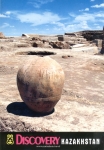The Jungar Alatau, in the south-east of Kazakhstan on the Chinese border, is a range of mountains between the Altai and the principal massifs of the Tien Shan. Some authorities regard it as a part, the northernmost, of the northern Tien Shan; others, persuaded by its remoteness from the Tien Shan, prefer to see it as an independent mountain system. Average mountain heights are around 3,500 meters; the highest is Semyonov Tienshanskii, at 4,622 meters. Glaciers in the Jungar Alatau cover twice the area that they occupy in the Altai, a fact partially explained by the relative humidity of the area, which only dries out properly for about a month a year, between mid-July and mid-August; although this in itself is a little odd given that the area is surrounded by semi-desert and arid steppe. Climate varies quite noticeably between the two ridges, the northern and the southern, of the Jungar Alatau, the northern having a pronounced Siberian-Altaic climate, while the southern ridge?s weather patterns are more similar to those of the Tien Shan.
Historically this area has been marked by unrest and conflict. The Jungar Gate, a stretch of lowland between the Jungar Alatau and the Tarbagatai mountains, was the favoured route of Genghis Khan and his forces on their way west. More recently, in the 1960s, the saline lake Zhalanashkol was the focus of an armed confrontation between the Soviet Union and China, the latter claiming it and the surrounding area as its own territory. The dispute was only resolved in 2003 when Kazakhstan ceded a large portion of the southern ridge, all the territory on the left bank of the River Khorgos, to the People?s Republic.
The dispute and the resulting official restrictions on access to the Jungar Alatau kept people and development away from the area: in most parts of the massif, but especially towards the eastern end of the northern ridge, there are no roads, tracks or other signs of human activity above the tree line. With the collapse of the Soviet kolkhoz-based agricultural system, even the pastureland was abandoned. The area remains virtually unpopulated and even visits are rare. This is good news for wildlife: among other fauna adapted to the climate and environment, marmot as well as the snow-leopard and two species of bear thrive here.
People are rather rarer: if you were to go on a three-week hike, chances are you?d see nobody else at all, except possibly on the first and last days, near your starting and end-points. So this is adventure territory. There are myriads of unclimbed, even unphotographed, mountains and mountain passes. An ideal format for a trip here would be a two- or three-week expedition combining trekking and climbing. We can suggest three routes here: start from the highest part of the Jungar Alatau, in the east near Semyonov Tienshanskii, and trek the 300 km west to the town of Tekeli, developing as a centre for trekking and starting point for hikes on the nearby Karatau ridge; alternatively, starting from Tekeli, proceed southwards and eastwards to explore the convoluted southern Jungar ridge; or start from the north and follow the Chinese border towards the south. Good luck!


